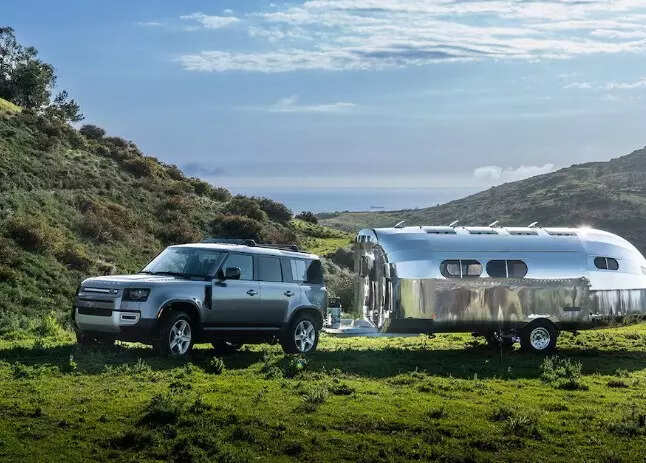
Most U.S. recreational vehicles – those behemoths of the roadway often resembling box cars that accidentally wandered off the rails – roll out of gritty factories in the gray environs of Elkhart, Indiana, and aim to satisfy the wanderlust of largely middle-income customers.
Then there’s the Bowlus, a very expensive travel trailer that can be towed by a Porsche sports car, no pick-up truck required.
Produced in the beach-front community of Oxnard, Calif., sporting 100 more days of sunshine in a year than Elkhart, it breaks most of the RV norms with a curvy 1930s design that sweeps back to a pointed tail, a minimalist interior, and a price tag for its top-end model – at USD 310,000 – that is equal to 80% of the cost of a typical single family home.
Bowlus shows that rich people really are different, at least when it comes to spending habits. Wealthy Americans have helped keep the U.S. economy rolling even as the Federal Reserve hiked interest rates to curb inflation, spending heavily on cars, houses, and travel.
Demand for the Bowlus surged during the COVID-19 pandemic, along with all RVs.
But as RV sales skidded – shipments of travel trailers plunged nearly 40% last year as the health crisis eased, according to the RV Industry Association – Bowlus kept selling every trailer it could make.
Now the company is expanding by offering a lower-priced version and selling through dealerships for the first time.
‘A MINDSET’
The mood of households in the top 25% of the income distribution has consistently run ahead of lower-earning groups since the start of last year, according to the University of Michigan’s closely watched sentiment gauge. In the latest fourth quarter, it stood at 71.3, while the comparable figure for the bottom 25% was 59.6.
“We also didn’t overproduce” during the pandemic, said Geneva Long, Bowlus’s CEO, when asked why her business held up while so many other producers struggled. One problem for the RV industry is that most factories hiked production during the pandemic to an unsustainable level and were then stuck with parking lots full of unsold trailers when demand suddenly cooled.
To be sure, it would be hard for Bowlus to overproduce. The factory, tucked in the back of a manicured industrial park here, only has room for 10 trailers on its main assembly line.
The company won’t discuss its financials, other than to say it plans to make 100 trailers this year–and then “expand every year while holding quality,” said Long.
And creating them is slow and painstaking. Bowlus’s 35 workers hand fashion the cabinetry, sew the seats made from a high-tech Japanese fabric, and hand rivet and polish the aluminum. The result is a trailer that lacks many of the amenities sought after in other expensive RVs, like spacious bathrooms or walls that slide out to create larger interior spaces.
Long said her customers appreciate the simplicity and the quality of her product. She’s also a bit of purist about camping culture–even the USD 310,000 model doesn’t come with a TV. However they plan to offer that as an option on all trailers going forward. “People who buy a Bowlus are the same people who buy airplanes, so it’s a mindset,” she said.
Other producers are jumping into the niche–including a battery-powered trailer being developed by another California company run by former tech executives.
‘COKE BOTTLE’
The Bowlus was first designed by a Los Angeles aerospace engineer during the Great Depression, who applied then-cutting edge airplane construction techniques – giving it a distinctive aluminum outer shell and aerodynamic flare.
He only built a handful before shutting down. Fast forward to 2014, when Long’s family revived the brand and started selling trailers in the same quirky shape as the original, with a pointed tail and its door at the front end.
The company has trademarked the shape. Long says it’s iconic, “like the Coke bottle.”
Bowlus is among the few RVs to use a structural system called monocoque – French for “single shell.” Like an airplane, a Bowlus is built with a complete outer skin of aluminum, including on the bottom, which avoids the need for a heavy frame and makes the trailers extremely light but strong. A Bowlus weighs about half as much as an equally long Airstream.
NOT ALONE
Bowlus is also part of a growing niche of smaller producers as well as old-line manufacturers who are developing new battery-powered trailers.
Aero Build, in Nashville, Tenn., has started selling 21-foot trailers with solar panels covering the roof. Like the Bowlus, it’s aimed at wealthier buyers. “We spare no expense on fit and finishes,” said CEO Brian Fuente. “Everything down to the frame is designed to last generations.” The price tag: USD 129,900.
Another startup, called Pebble, is developing a trailer powered by batteries that also help propel it down the highway, which increases range of the vehicle pulling it. One of the concerns with traditional RVs is that their heavy weight degrades the range of EVs as towing vehicles.
The Pebble starts at about USD 109,000, while Bowlus’s new, slightly shorter model lists for USD 165,000.
“The question we’re all trying to ascertain is what is the market for a high-end product like this,” said John North, CEO of Lazydays RV which operates 25 dealerships across the U.S. and just started offering Bowlus in five of them.
“We’ve had a number of customers interested,” he said, but, less than two months in, he’s still waiting for his first sale.

